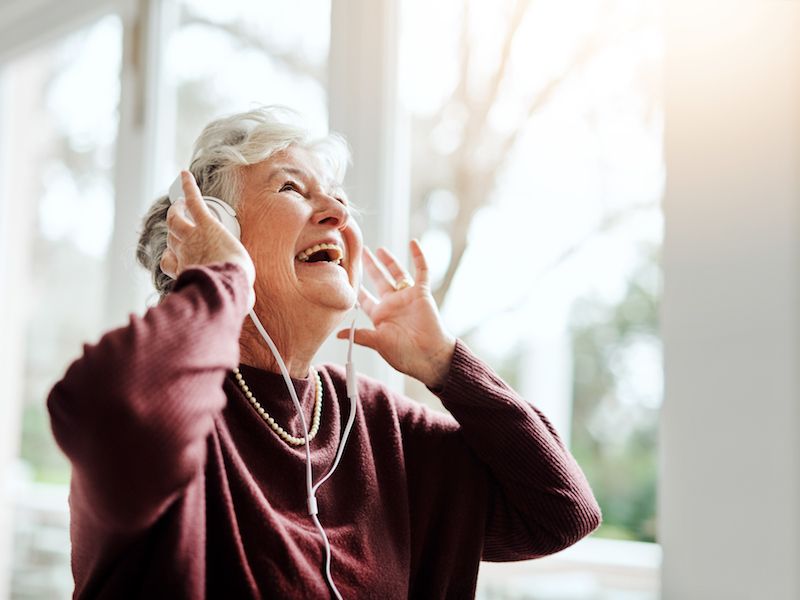
Noise-related loss of hearing doesn’t just affect people who work in loud surroundings, such as construction workers or heavy metal roadies. Recreation related noise exposure can be just as harmful as work related noise exposure. The most common kind? Loud noise heard through headphones, whether it’s gaming, streaming video, music, or even an audiobook with the volume turned up.
You may not realize your smartphone or tablet can go that loud. The average pain threshold for human hearing is about 150 db which is well within the range of these devices. Your ears will actually start to feel pain at this volume. So what’s the answer for safeguarding your hearing against volume related injury.
It’s significant here to think about the volume. A quick shorthand that’s widely suggested is the 60/60 rule: Listen with the volume at no more than 60% for 60 minutes or less at a stretch (because how long you listen for matters, too).
Create a Setting on Your Hearing Aids For Listening to Music
If you use hearing aids, you’re most likely streaming your device right to your hearing aids, so make certain the volume is not too loud or that you’re not trying to drown out other sounds with your music. Additionally, ask us about how to best listen to music. If you’re a musician or real music aficionado you may have noticed that most hearing aids are developed to sharpen the clarity of voices…not necessarily music. While enjoying music, we can most likely make a few adjustments to help better the quality of sound and lessen the feedback.
Choosing Headphones
If you don’t use hearing aids, there are a lot of choices for picking out headphones. There are some things to consider, although it’s generally a matter of personal choice.
Headphones That go Over The Ears
Over the ear headphones are becoming popular again but you probably won’t find the old foam covered speakers that used to come with a walkman. Often surprisingly pricey, they provide a large variety of color choices and celebrity endorsements, and of course, better sound quality. And unlike those little foam pads, these go over the whole ear, limiting outside sounds.
Main-stream wisdom is that these are less dangerous than in-ear headphones because the source of the sound is further away from your eardrum. But because the speakers are bigger they are normally capable of much higher volume. Also, noise-canceling will probably help you ignore the crying baby on your flight, but in other situations, it can block sounds you need to hear (such as a car honking). But on the positive side, you won’t need to contend with outside sound so you can listen to your music at lower volumes.
Earbuds
The normal earbuds are well known for poor sound quality, but because they come along with your phone a lot of people still use them. Particularly, with newer Apple phones, it’s simply easier to use the earbuds that came with the device because it most likely doesn’t have a headphone jack.
Earbuds also don’t block out sound so the drawback is, you tend to crank up the sound level. Once again,, though it’s frequently said that earbuds are problematic because you put them into your ear so their speakers are extremely close to your eardrum, volume is really the biggest issue.
Occluding or Isolating Earbuds
Many people choose earbuds with a rounded, rubbery tip both because they’re more comfortable than standard earbuds and better at blocking outside sounds. A seal that blocks outside sound from entering is formed by the rubber tip which conforms to the shape of the ear. But these earbuds can also block out noises you might need to hear and volume is still the main problem. And if you use hearing aids, obviously these won’t work for you.
A number of pairs might have to be tested before you find headphones that work for you. Your expectations, acoustically, will differ dependant on what type of use you usually give them. Enjoying your music at a healthy volume and coming across headphones that help you do that is essential.
How to be Certain Your Hearing is Protected
How can you be sure it’s okay? There’s an app for that…If you use a smartphone, you can get the National Institute for Occupational Safety and Health’s free Sound Level Meter app. There are other apps out there, but studies has discovered that the dependability of these other apps is hit-and-miss (in addition, for reasons yet unknown, Android-based apps have proven to be less accurate). That prompted NIOSH to develop an app of their own. The app enables you to measure outside noises, but you can also measure the sound coming from your device’s speakers, essentially, the true volume of what’s being sent to your ears. You have to do a little work, but putting in place these types of preventative steps can help safeguard your hearing.
